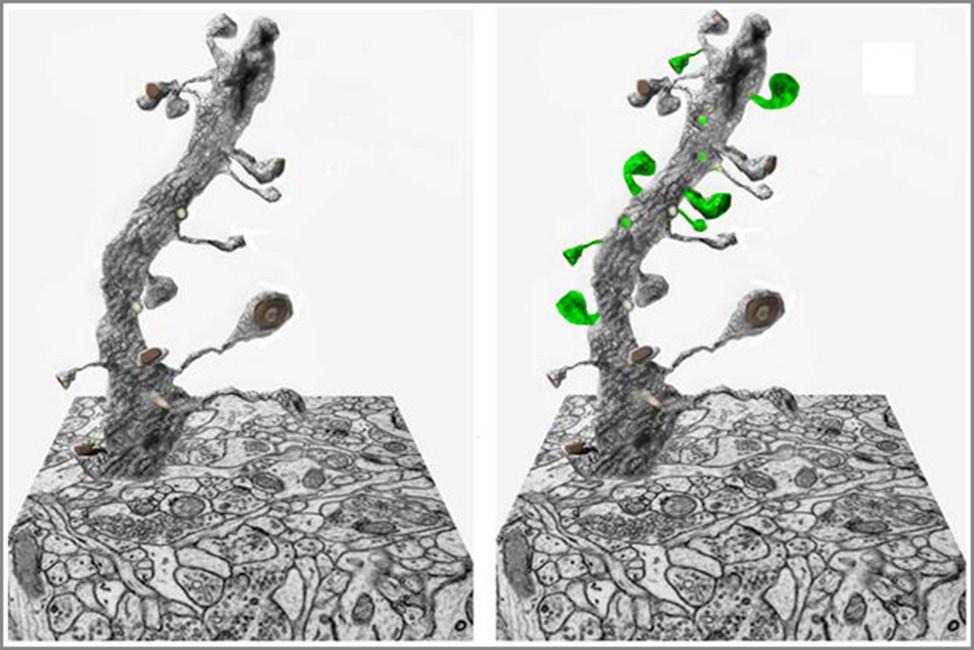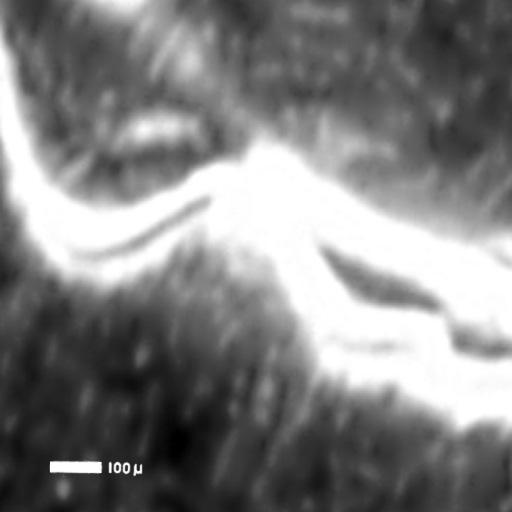
13 minute read
Revival of Cryonics Patients: Some Thoughts on Robustness of Memories
By R. Michael Perry, Ph.D.
Basic to the cryonics premise is the property that cryopreserved tissue would undergo very little change over substantial amounts of time stretching to centuries or more. This view is generally accepted by the scientific mainstream,[1] even though there is widespread skepticism that such preservation will eventually lead to the healthy revival of those who are so preserved.[2] The optimism of cryonicists regarding the prospects of revival depends on recognizing an informationtheoretic criterion of death: death has not happened, and revival can occur in principle, so long as there is enough identity-critical information in the preserved remains that the basic personality elements can still be inferred.[3]
Of central importance in this thinking is the presence or absence of structures or configurations in the brain encoding memories that delineate the life experience of the patient. If these structures are well-enough preserved the memories can be recovered. Apart from memories there should be ample information (through DNA for instance) to reconstruct a functioning body for the preserved individual, or to assist as needed in the repair and restoration of the preserved, original body to a healthy functioning state, so the patient truly “comes back.” Restoring the patient in his/ her original, biological body, possibly with extensive repairs or replacement of missing parts (especially in the case of neuropatients) is but one possible approach to the problem of revival. Another consists of “uploading” where identity-critical information is transferred to an advanced computational device of the future. After suitable processing which could be very extensive but informed by advanced knowledge, the patient with personality elements restored would “wake up” as a kind of program running in a virtual reality. (This condition is known as “whole brain emulation” or WBE but an entire surrounding world and virtual body for the patient could also be emulated, along with others who would share this world.) In this way biological and other limitations might be completely bypassed and the revival setting itself might be optimized in ways difficult or impossible with the more straightforward revival in a standalone body. (Some might prefer the standalone body for philosophical or other reasons, even if the uploading scenario proves workable and reliable. In any case it would be good to have different options.)
In either case all relevant information that can be extracted from the remains or other sources would reasonably be utilized. (Or at any rate, an amount of information deemed sufficient for revival must be extracted.) It seems a safe bet that in any reasonable cryonics case the worst deficit the revived patient would suffer is some amount of amnesia regarding episodic memories, which in turn could be at least partly alleviated through use of information extraneous to the patient’s remains such as written notes, photographs, historical records, and the like. A patient with even very poor preservation might thus emerge with the basic knowledge and skills they had before, including language proficiency, math and reading skills, motor skills and the like. They might also have considerable knowledge about themselves and others with whom they were acquainted, places they lived or attended school, jobs they had, organizations they were part of, and so on, all based on surviving information from one source or another.
Here the main focus will not be on how revival might be handled in the more compromised cases (including possibilities that go beyond the survival of relevant information in any form[18]). Instead, we explore the prospect that memory information will likely survive in the brain if the latter is not too damaged in passing from near clinical death to cryogenic temperature. The formation and storage of memories in the brain has been the focus of decades of intensive research yet much is still unknown.[19,20] Here we do not try to penetrate very far into this vast thicket of partially-understood complexity, but instead offer some basic, dimensional considerations that suggest that at least the storage of brain memories should be fairly robust.
Our starting point is the recently-completed, massively comprehensive study by Robert Freitas, Cryostasis Revival. [4] There he notes how in computer programs the information may be not at all robustly stored. “In computers, it is often possible that even a single flipped bit of data, if strategically located on a hard drive or in a software program, can produce disastrous consequences.” However: “There is an argument that human long-term memory is vastly more robust than this.” His argument starts with research in the 1980s to determine how much information a person can be expected to accumulate over a lifetime. (For completeness I include this material here though it largely repeats Freitas’s own summary elsewhere in this issue.)
“In 1986, Thomas Landauer estimated that the average rate at which humans accumulate information into long-term
memory during the normal activities of life, such as reading text or exposure to visual images, approximates 1-2 bits/sec, asymptotically approaching a stable lifetime total (integrating memory gains with losses) of ~2 x 109 bits for adults.[5] This figure should be compared to the best current estimates of ~86 x 109 neurons in the average human brain,[6] ~2 x 1014 synapses in the adult human neocortex,[7] and ~106 protein molecules per synapse.[8] While neurons and their synapses clearly perform many tasks unrelated to long-term memory storage, it would appear that up to ~43 neurons, ~100,000 synapses, and ~1011 protein molecules may be associated with each single bit of experienced, recallable, usable human memory. If long-term memory is truly this super-redundant, then it seems highly unlikely that the random loss of a single neuron, or the random corruption or misrepair of thousands of synapses or millions of proteins, could flip the associated single bit from ‘1’ to ‘0’ and destroy the tiniest piece of memory. This apparent robustness of the structures embodying long-term memory is consistent with the observation that human long-term memory persists over periods of many decades despite a turnover rate of ~0.7%/ hour for synaptic proteins – a half-life of only 2-5 days.[9] Such turnover means that every few days, roughly 1 out of every 20 proteins in every synapse is replaced with a new protein incorporating at least one random peptide sequencing error[10] – yet memory and personal identity persist, in many cases over a lifetime.”
Some additional data about the human brain will lead to estimates of expected volume-per-bit on a micrometer, not nanometer scale. Weight of cortex: 1,233 g; number of cortical neurons: 16 billion; weight of cerebellum: 154 g; number of cerebellar neurons: 69 billion; density of brain tissue: about 1.045 g/ cc.[11,12] From this we obtain in addition: volume of cortex: 1,180 cc; volume of cerebellum: 147 cc, total: 1,327 cc. Dividing the latter by the estimated 2 x109 bits for long-term memory in adults gives about 6.6 x 10-7 cc/bit or 660,000 cubic micrometers per bit, corresponding to a cube about 87 micrometers in height. (By comparison, the unaided human eye can see objects down to about 100 micrometers or 0.1 mm in size.[13]) This is what we would expect if the memory material were spread moreor-less uniformly over the entire total of cerebral cortex and cerebellum. Restricting to just the cerebral cortex would not change the cube height much (reducing it to 84 micrometers). As a more drastic restriction, suppose we assume that only .1% of the cerebral cortex or other brain volume stores all the 2 x 109 bits. This would reduce the cube height by an additional factor of 10 to 8.4 micrometers, still well above the nanometer size range of ultrastructural details in the brain, further reinforcing the impression of the robustness of long-term memories, whatever the details of how they are stored.
The brain in fact is a fantastic storage medium. One estimate pegs the total capacity of the cerebral cortex at about 74 TB or 600 trillion bits,[21] dwarfing the above estimated memory size by a factor of 300,000. However, I don’t interpret this as indicating the actual human memory is much larger than the figure arrived at by Landauer. Instead, more likely the extra bits of the cortex (and presumably other areas that may store memory information such as the cerebellum), to the extent they are used at all, are put to use to strengthen the encoding of the relatively few bits that are actually stored.
In much the same way a printed page in a book uses the molecular details of ink particles, wood fibers and the like to reliably capture the relatively modest contents of the visible text, that is to say, a few hundred words or (at most) a few thousand bits. If the brain functions analogously it could account for both the relative modesty of the memory as found by Landauer, and its noted durability over time. If so, it could also work much in our favor for the revival of cryonics patients. In such a process it still may be necessary to do a full molecular scan of the preserved tissue, to best judge what particular bits in the memory are encoded, particularly when substantial damage occurred prior to cryopreservation. The information retrieval, on the other hand, would arguably be the principal step in the whole revival process, other details such as whether particular cells which are damaged by freezing can be restored to functioning being less important or insignificant.
Possible mechanism for storage of memories in the brain. Left: three-dimensional reconstruction of dendrite of rat brain hippocampus, isolated from the surrounding tissue block. The dendrite, in the image resembling a gnarled tree trunk, has branching, bulb-tipped processes called dendritic spines that connect to axons or other processes via synapses and also store information including, it is thought, long-term memories. Right: same dendrite with additional dendritic spines imaginatively added (green, “new growth”) to illustrate expected appearance after storage of additional memory information. Height of dendrites is ~10 micrometers.[14-17]


Visualizing the microscale. Left: U. S. 25c piece of 2020, diameter 24,300μ or micrometers (also known as microns). Right: image shows enlargement of small detail highlighted in red in the left image, with scale bar indicating 100μ, which is about the limit of resolution of the human eye. According to the arguments presented here, the structures that encode bits of memory in the brain may be not much smaller than this, raising hopes that memories might be recoverable even from highly damaged neural tissue.
References
1. https://en.wikipedia.org/wiki/Cryobiology, accessed 26
Apr. 2022.
2. https://en.wikipedia.org/wiki/Cryonics, accessed 26 Apr. 2022.
3. https://www.merkle.com/definitions/infodeath.html, accessed 27 Apr. 2022.
4. Robert A. Freitas Jr., Cryostasis Revival: The Recovery of
Cryonics Patients through Nanomedicine, https://www. alcor.org/cryostasis-revival/, 69-70, accessed 26 Apr. 2022.
5. Landauer TK. How Much Do People Remember? Some
Estimates of the Quantity of Learned Information in
Long-term Memory. Cognitive Science 1986;10:477493; https://onlinelibrary.wiley.com/doi/pdf/10.1207/ s15516709cog1004_4. (The figure cited includes a generous allowance for motor memory, e.g., the information storage required when learning to play a piano, ride a bicycle, or perform gymnastics, which was not included in the original study; and incorporates an analysis of competing rates of both learning and forgetting.) 6. Azevedo FA, Carvalho LR, Grinberg LT, Farfel JM,
Ferretti RE, Leite RE, Jacob Filho W, Lent R, Herculano-
Houzel S. Equal numbers of neuronal and nonneuronal cells make the human brain an isometrically scaled-up primate brain. J Comp Neurol. 2009 Apr 10;513(5):53241; http://www.sakkyndig.com/psykologi/artvit/ frederico2009.pdf.
7. Pakkenberg B, Pelvig D, Marner L, Bundgaard MJ,
Gundersen HJ, Nyengaard JR, Regeur L. Aging and the human neocortex. Exp Gerontol. 2003 Jan-
Feb;38(1-2):95-9; http://citeseerx.ist.psu.edu/viewdoc/do wnload?doi=10.1.1.332.5850&rep=rep1&type=pdf.
8. Assuming the average chemical synapse is ~1000 nm tall, ~400 nm in diameter, ~1 kg/L in density, and composed of ~75 kilodalton protein molecules.
9. Cohen LD, Zuchman R, Sorokina O, Müller A, Dieterich
DC, Armstrong JD, Ziv T, Ziv NE. Metabolic turnover of synaptic proteins: kinetics, interdependencies and implications for synaptic maintenance. PLoS One. 2013
May 2;8(5):e63191; https://www.ncbi.nlm.nih.gov/pmc/ articles/PMC3642143/.
10. The typical error rate in protein synthesis is ~10-4 (https:// en.wikipedia.org/wiki/Kinetic_proofreading); assuming ~1000 residues/protein implies ~10% of all new protein molecules will contain at least one misincorporated amino acid.
11. Suzana Herculano-Houzel, “The Human Brain in
Numbers: A Linearly Scaled-up Primate Brain,” Front
Hum Neurosci. 2009; 3: 31, https://www.ncbi.nlm.nih. gov/pmc/articles/PMC2776484/#B3, accessed 26 Apr. 2022.
12. https://itis.swiss/virtual-population/tissue-properties/ database/density/, accessed 26 Apr. 2022.
13. https://www.wonderopolis.org/wonder/what-is-thesmallest-thing-you-can-see, accessed 27 Apr. 2022.
14. https://www.sciencedirect.com/topics/psychology/ dendrites, accessed 27 Apr. 2022.
15. Robert A. Freitas, op. cit., 70. 16. Michael Darwin, “Does Personal Identity Survive
Cryopreservation?”, http://chronopause.com/ chronopause.com/index.php/2011/02/23/does-personalidentity-survive-cryopreservation/, accessed 27 Apr. 2022.
17. Michael Darwin, private communication 23 Apr. 2022 (email).
18. R. Michael Perry, “Contrastive Underdetermination
Resolution, with Application to Cryonics Revival and Other Possibilities for Life after Clinical Death,”
Cryonics 40(1) (1Q 2019) 27-36.
19. https://en.wikipedia.org/wiki/Memory, accessed 27 Apr. 2022.
20. https://human-memory.net/the-study-of-human-memory/, accessed 27 Apr. 2022.
21. https://www.cnsnevada.com/what-is-the-memorycapacity-of-a-human-brain/, accessed 27 Apr. 2022.
Alcor Longevity Circle of Distinguished Donors
Support Alcor’s RAPID Research
The Alcor Board of Directors is pleased to announce the formation of the Alcor Longevity Circle of Distinguished Donors. This new organization will honor those members and their foundations that have donated in excess of $100,000 over the past few years to support Alcor and its affiliated organizations. In addition to being recognized in Alcor publications and at conferences and other events, members will also be entitled to: • Exclusive access and a quarterly conference call with Alcor Directors, officers, and officials to get in-depth briefings and ask questions and make suggestions. • Special recognition, seating, and access to officials at Alcor conferences.
• An exclusive yearly, hosted in-person event honoring members with face-to-face interaction with Alcor Directors, officers, and officials.

• A unique, professionally designed and engraved memento of their membership.
These benefits are, of course, overshadowed by the immense gratitude members’ and patients’ families will always have for these especially generous individuals. New levels of membership (higher and lower levels of participation) may also be announced in the future.
In order to advance the science and reputation of cryonics, Alcor plans to conduct ongoing research to develop novel and near-future products related to cryopreservation procedures and protocols. The RAPID team is developing relationships and contracts to procure recently deceased human cadavers, which are not Alcor members or patients, but are already earmarked for medical research. The idea is to procure one to two cadavers per month to conduct research. We would go on a “light standby” to enable fast access to cadavers.
The RAPID initiative will support cryonics research in multiple ways. Most immediately, it will help advance research into liquid ventilation – using a patient’s lungs as a heat exchanger to induce very rapid hypothermia. Animal studies alone cannot take LV development to the next level due to different chest anatomy. LV research will include cooling rate control; chest compression studies; and timing and sensor feedback.
RAPID will also enable research comparing chemical fixation to cryoprotection and will support rewarming studies. Another benefit will be a great improvement in cryonics-specific surgical training. That includes raising and cannulating the carotids; cephalic isolation; raising and cannulating the femoral arteries; field neuro procedure training; median sternotomy training; and alternate surgical approaches.
Alcor is requesting donations through GoFundMe. All donors will receive quarterly reports from Alcor regarding the progress with fundraising and milestone achievements rising from the RAPID program! Please donate today to support Alcor’s RAPID initiative. Alcor is a non-profit, federally tax-exempt, 501(c)(3) corporation and your donation may be tax deductible. Donate here: https://charity.gofundme.com/o/en/campaign/rapid-research/alcorlifeextensionfo For more information, see the presentation here: https://www.youtube.com/watch?v=BUaVcVMuFWQ&feature=youtu.be






